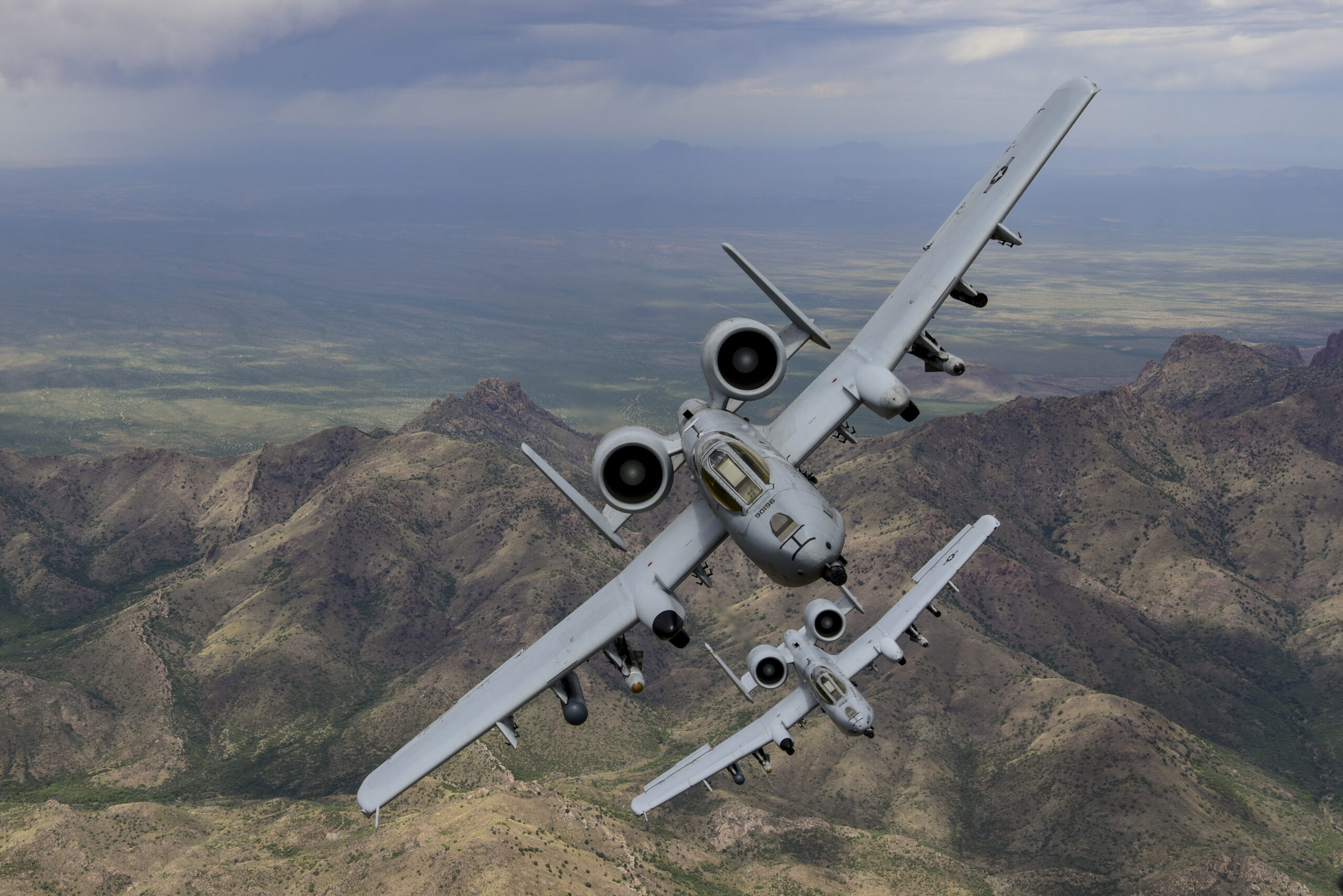Congress Protects F-22s from Retirement
Two A-10C Thunderbolt IIs fly in formation over southern Arizona, April 29, 2019. The A-10 is built around the GAU-8 Avenger 30MM Gatling gun and is capable of carrying an additional 16,000 pounds of munitions under the wings and belly of the aircraft. (U.S. Air Force photo by Staff Sgt. Betty R. Chevalier)
WASHINGTON — After years of fighting back, Congress is allowing the Air Force to part ways with a portion of its A-10 Warthog fleet, approving the service’s plans to retire 21 A-10s in fiscal 2023.
While it’s unclear whether this means the Air Force will be successful in future attempts to send the A-10 to the boneyard, the retirement of even a portion of the Warthog fleet — in this case, the squadrons from Fort Wayne Air National Guard Base in Indiana, which will get F-16s — is a massive step forward for the service, which has been locked in a debate with Congress over the future of the venerable ground attack plane for a decade.
But the FY23 National Defense Authorization Act, released Tuesday night, wasn’t all good news for the Air Force’s ambitious divestment plan, with House and Senate authorizers prohibiting the service from mothballing 33 of its oldest F-22 Block 20 Raptors. (House members overwhelmingly passed the NDAA today, while the Senate vote is expected soon.)
Service leaders have said those jets are not combat capable and will cost an estimated $1.8 billion over the next eight years. However, Congress’s defense of the current F-22 inventory was emphatic, with lawmakers including language that prohibit aircraft divestment — along with any drop in funding for personnel and sustainment — from FY23 to FY26.
And while the NDAA does not require the Air Force to upgrade its Block 20 F-22s, it calls for reports on the costs associated with upgrading those jets to a Block 30/35 configuration and the future of F-22 pilot training.
During FY23, the Air Force planned to divest upwards of 260 aircraft across multiple fleets, including some that had previously been conveyed to Congress in previous years. Lawmakers were largely content to allow the Air Force to move forward with a majority of the proposed aircraft retirements — with strings attached, for certain aircraft types.
The compromise NDAA allows the Air Force to lower its total fighter aircraft inventory from 1,970 to 1,800, which clears the way for the service to divest the 26 F-16C/Ds and 67 F-15 C/Ds as requested. However, House and Senate authorizers included language that forces the Air Force to provide a report on how planned F-15 divestments would impact current operations before mothballing those aircraft.
Congress took a phased approach for the E-3 Sentry airborne warning and control plane, better known as AWACS. The Air Force wanted to retire 15 of the 31 AWACS in its inventory. The NDAA only allows the service to draw down to a total aircraft inventory of 26 planes in FY23, but further aircraft can be retired if the Air Force meets certain criteria.
For instance, the service can reduce its inventory to 21 AWACS if it submits an acquisition strategy for the E-3’s successor—the E-7 Wedgetail. If it takes further action and awards a contract to Boeing for the Wedgetail, it can draw down to an inventory of 18 AWACS.
While also clearing the retirement of 12 HH-60G Pave Hawks, which will eventually be replaced by the new HH-60W Jolly Green II, lawmakers forbade the Air Force from taking steps to shut down Lockheed Martin’s HH-60W production line. The Air Force plans to truncate the HH-60W program after procuring its last 10 helicopters in FY23 — 38 aircraft fewer than planned.
With other platforms, Congress was more amenable to divestitures. The FY23 NDAA would amend an existing provision on the number of E-8C JSTARS ground surveillance aircraft the Air Force is required to maintain in its inventory, allowing the service to retire eight E-8Cs in FY23 and leaving just four JSTARS planes on active duty.
The bill permits the Air Force to retire 50 T-1 Jayhawk training aircraft, which are used to teach undergraduate mobility pilots before they move to platforms like the C-17 or KC-10. This will pave the way for the service to use only the T-6 Texan trainer to train cargo and tanker pilots.
In the realm of refueling tankers, the NDAA clears the Air Force to divest 10 KC-10s and 13 KC-135s in FY23, but retains a cap on the number of KC-135s the service is required to maintain in its primary mission aircraft inventory. (Of the 13 KC-135s set to be retired, one is already in already in backup inventory, a source told Breaking Defense.)
Finally, the bill gives a green light for the service to divest one EC-130H Compass Call electronic warfare aircraft and three EC-130J Commando Solo aircraft, which are used by special operators.
" Conservative News Daily does not always share or support the views and opinions expressed here; they are just those of the writer."






Now loading...